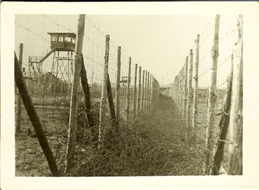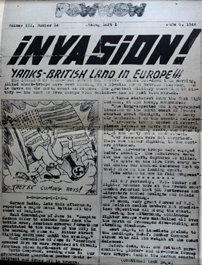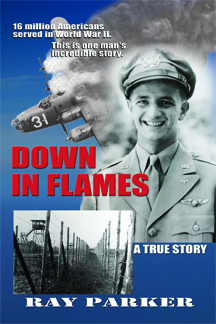The following day Ray Parker volunteered with the US Army Air Corp. Acing the entrance exam he is given the choice of Pilot, Bombardier, or Navigator. His first choice was pilot, but alas in practical training his aptitude came up short. He finds himself initially as a bombardier, and because of his exceptional abilities also qualifies as a navigator. So great is his aptitude that he is offered a position as an instructor. This he turns down in favor of being part of the ‘action’. A decision that I wonder if he regretted at times?
Training completed Ray finds him stationed in East Anglia, England, a region Ray describes as:
"..like an enormous aircraft carrier, housing some 130 military airfields."
There are few safe places to be when involved in war, and being part of a bomber crew certainly is not one of them. Bombers are relatively slow and not very maneuverable, they are also generally not well armed to defend themselves, relying instead on fighter support. Loss statistics for bombers in WWII were staggering, the normal tour of duty was to fly 25 missions, almost 50% failed. Many brave men lost their lives in the skies above Germany.
Half way through Ray’s tour of duty calamity struck, semi unconscious he was pushed out of the crashing plane by a crew member, miraculously, even though his parachute was not strapped on correctly he managed to safely make it back to terra firma. Unfortunately his parachute had been seen by German ground forces and they quickly catch him, the officer in charge tells him:
"Fuer Sie ist der Krieg vorbie – For you the war is over."
 Yet in many ways it is not. A prisoner of war he may be, and behind the barbed wire fences of Stalag Luft 1 Ray must sit out the active war. But he still participates in his own way. He takes over the production of the ‘underground’ camp newspaper. A newspaper that the inmates come to rely on for real news about the war. Unbeknown to the German captors the prisoners have a hidden radio, and every day they pick up the transmissions from the BBC. Using a typewriter four sheets of paper with carbons, Ray patiently produced the four copies that will circulate through the 9000 POW’s.
Yet in many ways it is not. A prisoner of war he may be, and behind the barbed wire fences of Stalag Luft 1 Ray must sit out the active war. But he still participates in his own way. He takes over the production of the ‘underground’ camp newspaper. A newspaper that the inmates come to rely on for real news about the war. Unbeknown to the German captors the prisoners have a hidden radio, and every day they pick up the transmissions from the BBC. Using a typewriter four sheets of paper with carbons, Ray patiently produced the four copies that will circulate through the 9000 POW’s.
 Down In Flames is a fabulous read, through the pages you get a real sense of what this period of time was like. Yes Ray had some youthful bravado, and certainly seemed to have enjoyed himself with the English damsels, but he also showed great courage in fighting for what he thought was right. I have read many books on WWII and most revel in the cruelty inflicted by the Germans on their prisoners. Ray has taken the high road on this subject and makes little mention of it. Sure food was lacking, Stalag Luft 1 was hardly the Ritz Carlton, yet Ray seemed to have taken most of this in a stoic fashion.
Down In Flames is a fabulous read, through the pages you get a real sense of what this period of time was like. Yes Ray had some youthful bravado, and certainly seemed to have enjoyed himself with the English damsels, but he also showed great courage in fighting for what he thought was right. I have read many books on WWII and most revel in the cruelty inflicted by the Germans on their prisoners. Ray has taken the high road on this subject and makes little mention of it. Sure food was lacking, Stalag Luft 1 was hardly the Ritz Carlton, yet Ray seemed to have taken most of this in a stoic fashion.
Great book! I can not recommend this one enough. For those of you not familiar with the name Ray Parker, let me tell you about his postwar exploits.
About the author: Ray Parker was a metropolitan newspaperman (LA Examiner, LA Times reporter, feature writer and rewrite man for both newspapers); handled public relations for the CBS TV west coast office, left to be head writer for Art Linkletter 1955-1968 (entire length of Art Linkletter’s House Party which ran on TV five days a week and was top-rated); Wrote two books for Art and two more for Dick Van Dyke about the funny things kids say; wrote a humor book after retiring about RVing, “RV Having Fun Yet?’’ which sold 10,000 copies. He also wrote for Dinah Shore’s daytime show, game shows for Goodson-Todman, served as senior writer for animation shows at Hanna Barbera Productions; did a radio show for “Dear Abby,” and spent three years as a staff writer for Bob Hope.
Now if that is not a busy career I do not know what is!
You can order your copy from Ray's web site - click on his book cover at the
Simon Barrett

